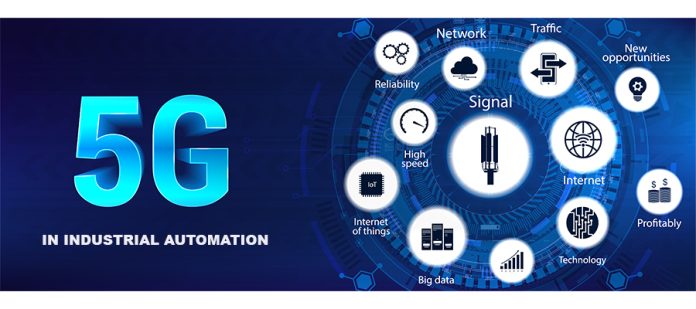The advent of 5G is poised to revolutionize industrial automation, propelling it to unprecedented levels. This next generation of cellular communications technology will significantly enhance the trend of integrating a factory’s operational technology (OT).  It encompasses its machinery, control systems, power infrastructure, and local and remote control software – with its information technology (IT) systems, including the communication network, enterprise resource planning (ERP) system, cloud services, and more.
It encompasses its machinery, control systems, power infrastructure, and local and remote control software – with its information technology (IT) systems, including the communication network, enterprise resource planning (ERP) system, cloud services, and more.
Sakshi Jain, Sr. Sub Editor-ELE Times had an opportunity to interact with Ludger Boeggering, Senior Principal Segment Manager EMEA Energy & Automation, u-blox. He talked about the industrial automation that will become more intricate and robust with the implementation of 5G technology. Excerpts.
ELE Times: What’s the difference between non-standalone and standalone 5G networks in automation?
Ludger Boeggering: From a technology point of view and according to 3GPP, the difference lies in the control logic. In the case of a non-standalone (NSA) 5G network, a 4G/LTE infrastructure is necessary to control the communication. While a standalone (SA) 5G network, on the other hand, is pure 5G implementation. From a user’s point of view, this means that implementation of a private 5G network (Non-Public Network, or NPN) based on SA is significantly leaner and costs less effort. From an application point of view, it is to be expected that an SA network will enable higher availability and reliability, as well as lower turnaround-time, especially in the context of NPNs.
ELE Times: Which industrial applications will benefit from 5G?
Ludger Boeggering: Since 5G is by definition an umbrella term for a wide range of technologies (eMBB, uRLLC, eMTC and RedCap), it will also enable a wide range of applications. To name just a few, predictive maintenance, environmental monitoring, service and configuration, connected tools as well as safe connected worker benefit from functions defined in eMTC and RedCap. eMTC is already available with LTE-M and NB-IoT and is being consistently developed further by 3GPP.
Furthermore, applications such as industrial assembly solutions, process automation control, human machine interface (HMI) and aiding via augmented reality, but also factory logistics, mobile robotics, cobots and AGV will benefit from the capabilities of RedCap and uRLLC. Above all, the focus here is on reliable response times with sufficient bandwidth and cost-efficient products.
The technology will be used across all relevant industry verticals in the coming years, for example manufacturing (machine, aerospace, automotive, semiconductors), chemical and petrochemical, pharmaceutical, oil and gas, energy and utilities, water and waste water treatment. This is certainly due to the technology itself, but also to the regulatory framework and the dedicated use of spectrum.
ELE Times: How does 5G in industrial automation enable instrument-grade EVM performance?
Ludger Boeggering: We first need to take the different characteristics of 5G into account.
In use cases that require high reliability and availability, low latency plays an important role. 5G offers by design significantly lower latency and higher availability compared to previous generations of mobile networks.
5G technology enables network slicing, which creates virtual networks tailored to specific applications or services. This allows industrial automation to have dedicated slices that are optimized for their specific needs and it also ensures high reliability and performance.
Edge computing will grow in importance in the future. 5G networks can use edge computing, which brings data processing closer to the devices and sensors. This reduces the time and energy required to transmit data to remote data centers, resulting in faster response times and improved performance in industrial automation processes.
And, last but not least, 5G supports mMTC, which allows a large number of devices to be connected simultaneously. In industrial automation, this means that numerous sensors, actuators and devices can be connected within the same network, improving overall efficiency in terms of utilisation and investment.
ELE Times: How does 5G in automation reduce machine dwell time, eliminate errors, improve material traceability, and allow employees to focus on tasks that require complex human skills?
Ludger Boeggering: The technology itself has little impact on these parameters. What matters is the implementation as a whole system. 5G allows secure communication environments to be created with an allocated frequency spectrum. Solutions based on wireless technologies are also much easier and more flexible to integrate into an industrial environment. This means that process data can be collected and analyzed in a more targeted manner. With these possibilities, one can create a digital twin and/or ensure a reliable status monitoring, which allows for preventive actions to be taken at any time. With smart use of this technology, processes can then be reliably executed and clever-as-a-service models can be built. This reduces downtime to a necessary minimum, avoids misproduction, and ensures that employees and materials are allocated in a targeted manner.
ELE Times: How does 5G speed up digitalization and reduce energy use?
Ludger Boeggering: 5G is another building block for mastering the challenges of implementing digitalization. Essentially, it helps to implement automation faster and promotes the desire for more flexibility. Key elements are availability and reliability
ELE Times: What are the potential challenges and limitations of using 5G in industrial automation?
Ludger Boeggering: Basically, I would first like to stress out that technology always follows the use case problem. The strengths of 5G also lie in its weaknesses – for example, time-critical applications in the milli- or even micro-second range will continue to be cable-based. No one will seriously spend the effort and costs today to build a corresponding 5G solution.
Even in the future, we will continue to find a variety of technologies in the industrial automation environment. One-size-fits-all does not exist.
If you still want to benefit from the advantages of flexibility and an independent, secure, campus-like area coverage, you will have to create a corresponding infrastructure, which entails an initial investment.
In the first described challenge of 5G technology use in industrial automation, one must manage expectations. More solutions will appear in the future to build the infrastructure, which will also allow small-scale deployments.
In addition, as many use cases as possible should use the same infrastructure to maximize user benefits. Network infrastructure must be designed to take these different requirements into account, and vendors must provide appropriate equipment.
Furthermore, a key aspect of implementing 5G in the automation environment is end-to-end traceability. The operator or integrator of a 5G-based solution must always be able to analyze every part of the communication infrastructure in order to quickly identify errors and restore operation.
ELE Times: What are the different frequency bands used in 5G for industrial automation, and what are their advantages?
Ludger Boeggering: This is a very broad question, and I would try to answer it more from a use case perspective. Let’s take as examples use cases such as predictive maintenance or environmental monitoring, where the focus is on deep penetration, high subscriber numbers and easy-to-use existing infrastructure. This mainly involves the use of the traditional spectrum bands of the public network providers.
In other use cases, such as process automation control and aiding via augmented reality, availability and reliability are paramount. This is where the strengths of private networks, including data security, come into full play. The spectrum available for such installations is in the mid-GHz range between 3.xx and 4.xx GHz, and the relevant licences for individual spectrums have been issued by regulatory authorities for a number of years on comparatively attractive terms for local use.








